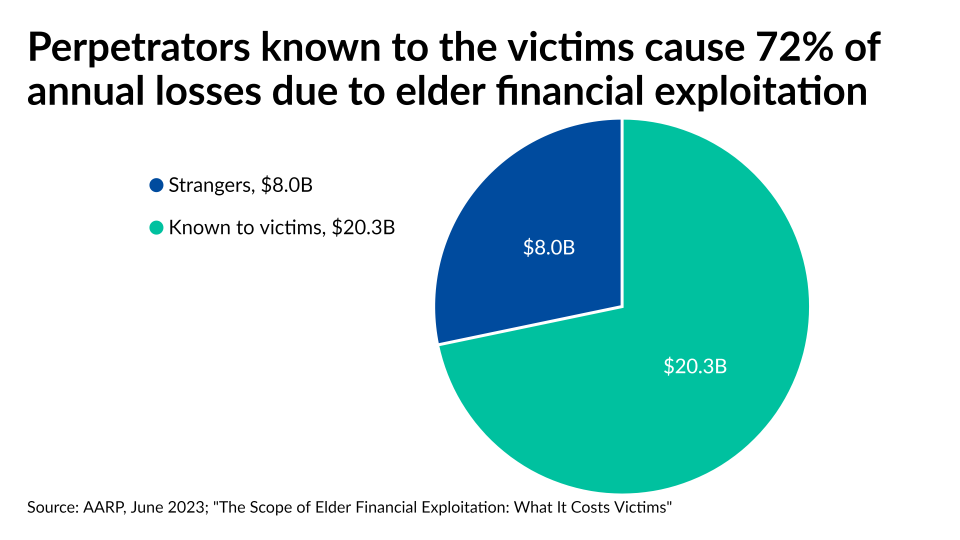The disturbing size of elder financial abuse in America

As financial advisors, wealth management firms and law enforcement agencies struggle to prevent elder financial exploitation, a new AARP study showed the size of the problem.
Victims aged 60 or older lose $28.3 billion each year to elder financial exploitation schemes, with 72% of the damages inflicted by people who know them. The same percentage goes unreported to authorities or the industry, according to the study, authored by Jilenne Gunther, the national director of AARP's BankSafe Initiative, and released earlier this month in a collaboration with NORC at the University of Chicago. Previous studies cited in AARP's report estimated the annual losses at $2.9 billion, $36.5 billion and $273.5 billion.
"Understanding of the problem continues to grow with a dollar cost identified and awareness of the need to look well beyond dollar figures — because the true cost extends far beyond the
$28.3 billion calculated here," Gunther wrote in the report. "There are the rippling effects within society, such as in the form of tax dollars spent on programs needed by those whose resources are depleted from [elder financial exploitation], not to mention the billions of dollars lost by the financial industry, for which consumers ultimately pay. And then there are the truly human impacts, which other research has begun to identify, such as on older adults' mental and physical health."
Advisors and wealth management firms, as well as securities regulators and local, state and federal law enforcement, play a pivotal role in efforts to detect fraud targeting older adults. Frequent regulatory and criminal cases, including some prosecuted as hate crimes, suggest any success in cracking down on elder financial exploitation has been limited at best.
The rising median age of Americans amid the graying of baby boomers makes the "escalating" issue even more urgent, according to Paul Greenwood, the founder of Greenwood Law and a former prosecutor who led a unit of the San Diego County District Attorney's Office focusing on crimes targeting older victims.
"The legislators and politicians need to treat this as a national crisis. They need to find sufficient funding for Adult Protective Services. It is appalling that APS in every state struggles to keep up with the rising caseloads," Greenwood said in an email. "There have been some notable successes in recent years thanks to excellent collaboration between local, state and federal agencies. We need more of that. It is possible to 'follow the money' even if it ends up overseas. It just takes people with a passion, perseverance and purpose."
AARP's study used "a first-of-its-kind approach that gathers data from several of the nation's most highly regarded sources on consumer-reported losses and eliminates duplicate reports while integrating estimated unreported losses," according to the advocacy and membership organization for older Americans. The report pulled data from three federal sources previously identified by the U.S. Government Accountability Office, an independent watchdog agency: the Federal Trade Commission's Consumer Sentinel Network, the FBI's Internet Crime Complaint Center and suspicious activity reports filed by financial firms to the Treasury Department.
Defining elder financial exploitation as "the illegal or improper use of an older adult's funds, property, or assets," AARP found that the losses stemming from perpetrators known to the victims are driving the tens of billions of dollars in unreported costs. At least 67% of victims told authorities or financial institutions about their losses at the hands of strangers. Just 12.5% of victims who lost money to someone they already knew alerted government agencies or firms.
"The nature of stranger-perpetrated fraud bears little resemblance to fraud initiated by people the victim knows," Gunther wrote in the report. "While strangers may rely on quick and irreversible transactions such as gift cards or wire transfers, perpetrators familiar to the victim are more likely to make incremental inroads, gaining direct access to funds, for example, by attaining joint ownership or power of attorney status on their victims' accounts."
AARP's study "serves as a starting point" for the necessary "development of interventions that can protect older adults, and society at large, from the seismic impacts of this pervasive problem," Gunther concluded.
For example, the organization's BankSafe program has blocked more than $200 million from being stolen from older Americans through training and educational efforts alongside more than 1,000 participating financial companies, she noted in a statement.
FINRA recently released a podcast for "elder abuse awareness month" with a listing of resources for industry professionals on rules and best practices. The Department of Justice, the FBI, the Securities and Exchange Commission, the North American Securities Administrators Association and the Consumer Financial Protection Bureau each have more information about how to report and catch elder abuse as well.
"Every police and sheriff department" in the country should complete a course called "Elder Abuse Guide for Law Enforcement" or (EAGLE), a federally funded module developed at the National Center on Elder Abuse at the University of Southern California's Keck School of Medicine, according to Greenwood. Adult protective agencies need as many case workers as the government units tasked with preventing child abuse, government agencies and the industry ought to strengthen their networks and financial institutions must ramp up their training, he said.
"Could the numbers be much higher? I believe so," Greenwood said. "The predators out there rely on the fact that either victims are too embarrassed to come forward or are cognitively impaired and fail to grasp the severity of their situation. Will this only get worse? Yes."
